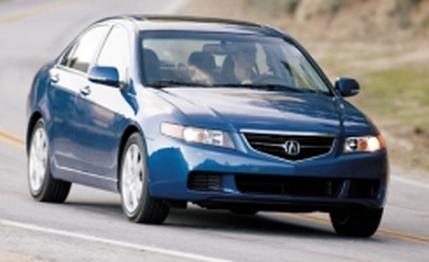
 First Drive Review
First Drive Review
The one consistent truism in the modern car business is this: To say unkind things about the BMW 3-series is to reveal yourself as an infidel or idiot. Possibly both.So pervasive is the acceptance of 3-series superiority in sports sedans that seemingly not a month passes when some carmaker isn't selling us on its new 3-series copy. Imitation remains the sincerest form of flattery. Many are good cars, some are good enough to make our 10Best list, but none beats the 3-series at its own game.
So imagine Acura's predicament. Not only is the TSX, on sale this April, the first time the Honda subsidiary has admitted to going directly after BMW, but, well, it's not a very good copy, is it? Look at it. Its pointed nose protrudes more than the fashionable few inches beyond the leading edge of the front wheels. It has driveshafts in the front, but none driving the rear wheels. And in its haste, Acura has forgotten to add the fifth and sixth cylinders to the engine.
All of this must be very embarrassing for the company, which is typically known for its quick-wittedness. Surely, Acura is not so daft as to believe it could fool car enthusiasts with some tarted-up front-drive, four-cylinder family sedan.
Well, yes, it is. The TSX is, in fact, a European- and Japanese-market Honda Accord, modified for U.S. sale with more power, more standard equipment, a dose of new marketing, and an "Acura TSX" badge.
This makes it an utter failure as a tool of 3-series worship and yet something altogether more interesting than another copy. In its hunt for the 3-series, Acura has inadvertently conjured up the spirit of the old Nissan Maxima. Here we refer to the '89 through '94 models to which Nissan affixed "4DSC" stickers (for "four-door sports car"), not the softer, larger cars that followed. The TSX is the car for those who need space, want fun, and haven't the money for an impressive badge.
The TSX has a shorter wheelbase (by almost three inches) and overall length (by about six inches) and is narrower (by about two inches) than the U.S. Accord.
The suspension setup, with dual control arms up front and a five-link independent rear, is the same basic configuration that underpins the Accord in this country. The TSX's suspension, though, is tuned considerably stiffer with a larger rear anti-roll bar than on the U.S. Accord. The Acura rides on standard 17-inch wheels carrying 215/50 all-season performance Michelins. The result is a surprisingly agile car. Even at more than 3200 pounds (about 120 heavier than a four-cylinder Accord EX), the TSX feels light on its feet in a way that will be familiar to Honda owners. German sports sedans, by comparison, tend to feel stout-even heavy-over the road.
The TSX has far better body control than does an American Accord. There's a bit more body roll than expected, though, so it's not exactly in BMW territory. But it leans in a controlled and progressive manner that doesn't really inhibit hard driving. Midcorner bumps and hillocks upset the car almost not at all. This inspires confidence-perhaps a bit more than the tires are prepared for. We applaud Acura for using a decent-size tire, but we'd like more aggressive tires than these.
Despite its general handiness, the TSX can conceal its front-drive nature for only so long. Drive really hard, and the 3-series posing fades quicker than the front tires' grip on the pavement. The quick-ratio steering is light, accurate, and nearly immune to kickback, but its numbness doesn't warn the driver that those tires are about to give up the fight. Driven as if you were the guy making the payments, the TSX is plenty satisfying. Acura tried to reduce the weight up front, including using a lightweight magnesium manual transaxle case, but, like an American Accord, the TSX carries 60 percent of its weight over the front axle.